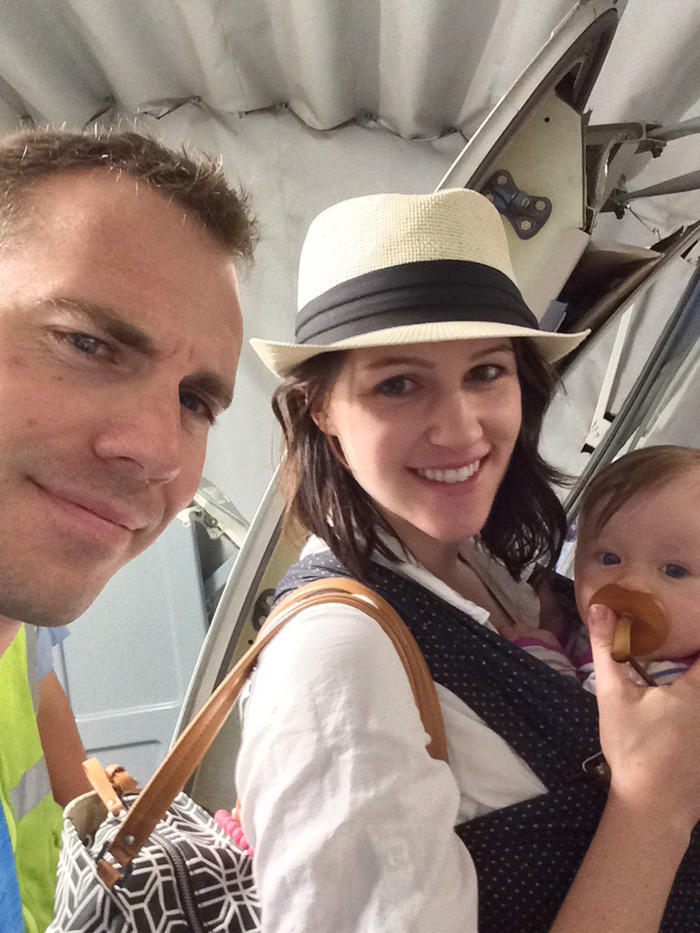The Unfriendly Experience of Flying the Friendly Skies
14 min read
As we move across the globe, we’ve all had travel plans upended. If it’s not a delayed flight, it’s lost baggage. If it’s not lost baggage, it’s a hold up in the security line. If it’s not the security line, it’s the lack of service.
The experience is flawed, and while no one can control blizzards and hurricanes, there are numerous things that could be improved with air travel—especially when traveling with children.
I’m a new mom, and for the first time, I was the one with a haggard look, screaming baby, and a ridiculous amount of stuff.
As you read my story, please know that it’s my day job to be [constructively] critical of experiences. I’m a UX professional with a particularly keen eye for areas of improvement and a slim tolerance for lack of empathy.
When I first had my baby, going on a walk was an event; going to Target was like planning a vacation. So the thought of leaving the state and flying on an airplane with a four-month old sounded stressful, to say the least. I wondered, more than a few times, if we would have enough body parts to carry two large suitcases, two carry-ons, a stroller, a car seat, a DockaTot, and the baby. Can’t forget the baby.
Before the Flight
Purchasing airline tickets always leaves me feeling a little anxious.
What if there’s a typo in my name and they don’t let me on the plane? What if this vacation is a bad idea? Should I really spend the money? How disruptive will it be to my workload?
But this time, it wasn’t just about me. It was about me and a baby. My pile of anxiety grew to include questions like:
How will we pack everything (I said I wasn’t going to be one of those people, but we really need most of that stuff)? What if she cries the entire flight? What if she cries the entire trip? How will she handle the altitude in Colorado? How will she sleep (She doesn’t sleep well at home, there’s no way she will sleep on vacation)? What if the car seat gets broken in transport?
I had a hundred new things to think about this time around, and when you add all of that to a sleep-deprived mom brain, you end up with a pile of mush that can’t make a decision.
So I wrestled with the idea for weeks. I talked pros and cons with my husband, friends, family, and co-workers. I talked myself into it. I talked myself out of it. And when I finally clicked “purchase ticket”, I assumed everything was completed correctly for traveling with a small child, but I really had no idea. The only difference was one small check box. This huge, anxiety-filled decision came down to one check box.
As the days ticked off the calendar, the trip started to become a reality. I needed to find out how this was going to work, and I had so many questions. Do I have to pay for the stroller and car seat? How do I take a baby through security? Will she need her birth certificate?
I scrolled through Frontier’s website hoping to find something related to flying with a baby. After a few minutes of looking, I gave up and found a customer service number.
When I tried to call, I couldn’t easily figure out how to get the answers I needed; I couldn’t even figure out how to get to a real person. After few minutes pressing buttons, I ran out of patience—it’s in short supply these days—and hung up.
Frontier, here is how you could have improved my experience:
1. When confirming my ticket purchase, express that you’ve noticed that I’m traveling with a child.
Something as small as, “We see you’re traveling with a small child. Don’t worry, we’re here to make this as easy as possible,” would have been reassuring. Conversational copy can go a long ways in making your brand feel more human and, in turn, more relatable.
Conversational copy makes your brand feel more human and, in turn, more relatable.
2. Tell me what to expect.
As soon as I complete my purchase, provide a 1-page overview of what to expect when traveling with a small child, and clearly outline what I can or can’t bring and/or do.
If you want to make this even better, include some tips—what to pack, when to feed, etc. This shows a level of empathy for my situation, and it’s a small gesture that saves me from having to hunt down pointers from blogs and family friends. I don’t have time for that.
3. Nix the automated systems.
Give me the option to talk to a real person from the get-go. It will save all of us time. In fact, according to Stella Service, customers that call companies with real people are on hold for an average of only 51 seconds, versus 1 minute, 51 seconds, when calling an automated system. New moms need every minute, people.
Cedar Rapids to Denver
Based on what I had read and heard, I assumed we would be checking the stroller and car seat at the gate, so I was surprised when the woman behind the counter insisted we check the items with the rest of our luggage. I was slightly concerned about how they would be treated—I’ve seen the way luggage gets thrown around—but she seemed to think it was our best option.
At this point, I should have put my baby in her carrier, but I didn’t know if I could wear her through security (I actually still don’t know if that is acceptable). She was too young to hold onto me, so the carrier would have made tasks like taking my shoes off and finding the liquids in my diaper bag considerably easier. Because, let’s be honest, it’s hard to do those things quickly even with two hands and no baby.
Frontier/Cedar Rapids Airport, here is how you could have improved my experience:
1. Install signage.
I want to follow the rules—believe me—but to do that, I need to know them. There wasn’t a single sign about how/where/when to check my stroller and car seat or how to efficiently get through security.
There are instructions for the elderly, but not people traveling with infants. All we want to do is get through the line before our baby screams, spits up, or blows out her diaper. She is a little ticking time bomb. Don’t you know that?
2. Let me keep my shoes on.
Give me a pat down, search my bags—whatever. Just find a way to let me keep my shoes on. I can’t wear flip-flops all year-round, and I refuse to wear velcro.
3. Create a kid zone.
Build a play area for 0-5(?)-year-olds. Yes, I know, every two-year-old has an iPad, but a little non-digital play can be refreshing. Plus, it would keep them off your escalators and would probably make parents a little more patient with your employees while waiting for a delayed flight.
My baby on the airport floor. Where’s the kid zone?
Personally, I would have liked a space where I could lay my baby down to stretch her legs without feeling like I was putting her on an airport floor.
Denver to Cedar Rapids
We arrived at DIA later than we had hoped (sometimes we forget how long it can take to pack up a tiny human and all of her belongings), and of course, the check-in line was considerably longer than the one in Cedar Rapids.
But this time, I was feeling much more confident. She was smiling in her carrier, the stroller/car seat was ready to be checked, and I had my ID out of my wallet. It appeared that I knew what I was doing. Then it all went sideways.
When we got to the counter, the woman ignored our stroller until we asked to check it. She told us we would need to do it at the gate, even after explaining that we checked it on our flight here and would like to do it again.
I couldn’t understand why the same airline would have different procedures.
During this conversation, my baby decided she was hungry and wanted to tell everyone about it (through blood curdling screams). I’ve never felt more conspicuous. I made a beeline out of the ticket area and found a place to feed her. And by “found a place”, I mean the floor of the walkway to security.
Time was ticking, my husband was pacing, and we had no idea what was in store for us in the security line.
Since I had her out of the stroller, and I didn’t want puke inside my shirt, I decided to just carry her the old-fashion way. At some point, I got tired and put her back in the stroller, thinking she could stay in there while we went through security. Silly me.
The person checking IDs didn’t have anything to say about it, but once we got to the conveyer belt (which took awhile) I was told she had to come out of the stroller.
Talk about comedic timing. At the very worst possible moment—I’m frantically grabbing buckets, pulling things from my bag, and removing clothing as fast as possible to avoid holding up the line anymore than I have to (because I packed half of my house)—they decided to tell me that I need to do all of this while holding my baby. Great. Fine. Whatever.
Once I grabbed her, they instructed us to put the stroller “over there.” There was no designated spot, or instructions, just an agent with divided attention telling us what to do (once we did it wrong).
My husband left the stroller and continued through the full-body scanner. I wasn’t allowed to go through it with my baby, and was told to go stand by the other lady with a baby (again, no sign).
As we waited, some of my things came through the machine, and I started putting my shoes back on. Moms are in the business of multi-tasking—not just standing around—so I thought it made sense to pack up while we waited. Wrong. I ended up getting the verbal equivalent of a hand slap: “Ma’am, do not touch your stuff.”
Meanwhile, the agent had gone over to inspect the stroller/car seat and preceded to tell us it needed to be taken apart. Since I was in TSA purgatory, my husband had to go back and do it. Once he removed the car seat, he started walking back to the benches to wait.
But as he passed the scanner, he was told he actually had to put his shoes through the x-ray machine and get in line, even though they just saw him go through three minutes ago. I’m not sure what shenanigans they thought he could pull off in front of all the agents and passengers.
Just as he was about to walk through the scanner, the agent told us we actually had to remove everything from the stroller and send all items through the x-ray. There were things in the bottom of the stroller that I didn’t even remember putting there—flip flops, books, burp rags, bows, sunscreen, granola bars—and I hadn’t planned on caring about any of it, because it was supposed be in the checked luggage.
By this point, I could see the stress on my husband’s face and the sweat beads forming, so I left purgatory with my baby (but without my shoes) and helped him.
Once that was finally taken care of, the agent swabbed my hands. I’m not exactly sure what they’d be swabbing for on the hands of a mother of a 4-month-old…baby powder?
Then he casually mentioned that I could pack up my things. I held it together, but gave him an exasperated look and considered handing him my baby. How did he expect me to “pack up my things” when my stroller was in pieces, I had five buckets worth of personal items, and my husband was back in the security line? Oh, and did I mention our flight was boarding in less than 10 minutes and she still needed a diaper/clothing change?
We made it. But barely.
 I’m the only one who could muster a smile post-TSA.
I’m the only one who could muster a smile post-TSA.
Frontier/DIA here is how you could have improved my experience:
1. Give me a sign.
Again, any type of sign would have helped. Help me help you. Even if it said something like, “If you have kids, you’re screwed,” at least I would have known what I was getting myself into.
2. Be consistent.
When we think about the digital realm of user experience, we talk a lot about framework and the importance of consistency—when a user learns one thing, they actually learn 10.
For example, everyone knows they need to check-in and then go through security when at an airport. However, the methods by which that is done can vary across airlines, airports, and passenger types. Consistency would help us all learn faster, and be less disappointed in even a lackluster experience.
3. Designate a security line for families with kids in-tow.
Since you are a larger airport, create a family-friendly security line. This line would only be used by people with kids (and all of their kids’ stuff). There would be no expectations of speed or someone angrily sighing behind you, because they would get it. Plus, your staff would know the drill and could quickly and easily outline the rules for us newbies.
4. Again, create a kid zone.
We would not have had any time to use a play area on this particular flight, but I still think it would be a valuable addition to any airport.
5. Cross-market with baby equipment rental businesses.
Since our trip, I have found various businesses that rent out baby equipment (why didn’t I know this before?).
As an airport, why wouldn’t you partner with and promote these businesses? Less hassle for you and me in the TSA line.
6. Anticipate passenger (user) errors.
You need to consider (our) user errors. Why couldn’t two college educated people figure out your system? Most likely because there is gap between the way it was designed and the passengers’ mental model (one’s internal representation—imagined or perceived—of how an event will unfold and what they need to know or have to successfully navigate that event).
If you don’t plan to redesign the system, at least understand how to help users avoid common errors through some type of communication (signs, emails, people).
If we do fail, which we will, don’t put the failure on us; help us learn for next time. Think, “Ma’am, I know you’re in a hurry (this shows empathy), but you’ll need to wait until I swab your hands,” instead of, “Ma’am, do not touch your stuff.” It’s the very least you can do when you call me “Ma’am.”
We all made it back in one piece (with only a few casualties to our belongings), but I can’t help but reflect on my experience and think it should have been better.
According to IATA, more than 8 million people fly the friendly skies every day. That means there are 8 million opportunities every day to make someone’s experience better.
There are 8 million opportunities every day to make someone’s experience better.
Frontier, TSA, and the airline industry: I challenge you to do better.
Do you think anyone designed the airport system with the passenger in mind? Do you think the user mental model matches the design?





